|

Pages: << Back 6
7 8 9
10 11
12 13 14
By the late '70s important innovations in teaching methods and content
were appearing which foreshadowed the breakdown of the prescribed
curriculum and the textbook recitations. There were more faculty
lectures in certain fields, and students began to use laboratories
in both the physical and biological sciences. A rudimentary chemistry
laboratory was equipped in the basement of East
College. The Latin department introduced an "honors"
program in 1879 and the 1882-83 catalogue announced first- and second-class
honors in all departments, requiring additional work beyond the
regular course of study. The university also moved in the direction
of an elective system in 1879 by permitting some choice among subjects
in both the Classical and Philosophical curriculum. Apparently the
first departmental club was a chapter of the Indiana Scientific
Association which was founded in 1875. Six years later the Social
Science and Political Club appeared, choosing for its first topic
of discussion the question of women's suffrage.
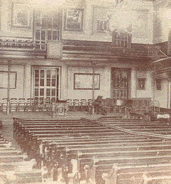
The
fine arts had no place in the early Asbury curriculum, though informal
musical organizations made their appearance from time to time. The
first formal arrangements for instruction in music and art were
made in 1877. The university contracted with Emanuel Marquis, a
German immigrant who operated a music store in Greencastle, to furnish
instruments and offer lessons in piano and organ. It also engaged
a local artist Elizabeth Adelaide Clark, to teach drawing and painting.
All these were offered on an individual fee basis. By 1880 a Mozart
Society and a college choir had been established. The next year
Asbury graduate Minnie Langdon was authorized to teach piano and
organ and registered five students. Finally, in June 1882, the trustees
voted to establish a Department of Music, which opened the following
January under the director of mathematics professor John P. D. John.
He was assisted by Professor De Motte, who conducted the orchestra,
and by Minnie Langdon and two faculty wives, Ora John and Ella Earp,
teaching piano and voice.
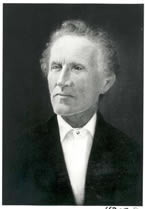 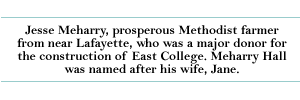
The
instruction in art offered by Elizabeth Clark had come to an end,
but in September 1883, another artist, John Western, was granted
permission to use a college room for a class in drawing. By the
closing years of the Asbury period its educational program was slowly
but surely gaining greater breadth and
flexibility.
Financial troubles continued to beset the university. Having introduced a system of free tuition in 1873, the trustees had nullified
the many scholarships that had been sold to finance the institution
in earlier years. An increased but still modest student contingency
fee of $15 per year, together with income from the small endowment,
proved insufficient to meet annual expenses. The depression of the
1870s meant default and decreased interest on railroad and other
bonds held by the university. In 1876-77 the annual deficit was
over $10,000, and it reached $11,000 in 1883-84. No wonder President
Andrus was discouraged enough to resign!
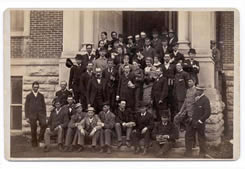
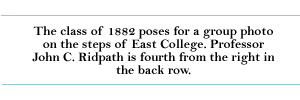 Indiana Asbury came close to going under and might have closed as
similar institutions were forced to do at this time, had not a financial
savior appeared in the person of New Albany industrialist Washington
C. DePauw, president of the board of trustees. After long and
complicated negotiations between DePauw and the trustees and officers
of the university, he agreed to make a substantial contribution
to the institution. In return Indiana Asbury was to be renamed DePauw
University and to embark upon an ambitious program of expansion
of its facilities and educational programs. By May 1884 Old Asbury
had passed into history, though mourned by many of its alumni. In
its place arose a new and greater DePauw University, which was to
carry on the old traditions while at the same time extending the
scope and reach of the much-loved institution.
Indiana Asbury came close to going under and might have closed as
similar institutions were forced to do at this time, had not a financial
savior appeared in the person of New Albany industrialist Washington
C. DePauw, president of the board of trustees. After long and
complicated negotiations between DePauw and the trustees and officers
of the university, he agreed to make a substantial contribution
to the institution. In return Indiana Asbury was to be renamed DePauw
University and to embark upon an ambitious program of expansion
of its facilities and educational programs. By May 1884 Old Asbury
had passed into history, though mourned by many of its alumni. In
its place arose a new and greater DePauw University, which was to
carry on the old traditions while at the same time extending the
scope and reach of the much-loved institution.
 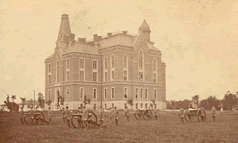
David
Graham Phillips, who attended Indiana Asbury in its closing years,
wrote a novel entitled The Cost. Its central character resembled
his college roommate, Albert J. Beveridge, who later became a distinguished
U.S. senator. In the book, the novelist penned a vivid description
of his fellow students at thinly disguised "Battle Field University,"
which may serve as an appropriate epitaph for the institution:
Most ... came from the farms of that western country, the young
men with bodies and brains that were strong but awkward. Almost
all were working their way through - as were not a few of the women.
They felt that life was a large, serious business impatiently waiting
for them to come and attend to it in a large, serious way better
than it had ever been attended to before. They studied hard; they
practiced oratory and debating. Their talk was of history and philosophy,
religion and politics. They slept little; they thought-or tried
to think-even more than they talked.
Back
to Top
Pages:
<< Back 6
7 8 9
10 11
12 13 14
|






 Indiana Asbury came close to going under and might have closed as
similar institutions were forced to do at this time, had not a financial
savior appeared in the person of New Albany industrialist
Indiana Asbury came close to going under and might have closed as
similar institutions were forced to do at this time, had not a financial
savior appeared in the person of New Albany industrialist 
